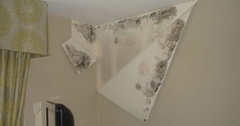Blog Post
What is Toxic Black Mold or Stachybotrys? What Are the Symptoms I Should Lookout For?

Toxic black mold is the name commonly used for "Stachybotrys chartarum". Stachybotrys produces toxins called mycotoxins which are extremely dangerous to humans. Black mold can grow undetected in homes and in turn, affecting the health of unsuspecting dwellers.
What Does Toxic Black Mold Look Like
Toxic black mold is a greenish-black gelatinous mold which is usually slimy due to a wet top layer. Take note, it can appear dry and powdery if the colony's water source runs out. Several types of non-toxic mold do look similar to the toxic variety. The only way to determine if the mold you have is black mold is to have a mold expert look at a sample under a microscope.
Toxic Black Mold Symptoms
The mycotoxins released by toxic black mold cause people to suffer toxic symptoms. The general types of symptoms caused by being exposed include…
- Respiratory problems
- Skin inflammation
- Hemorrhage
- Irritation of the mucous membranes
- Damage to internal organs
- Mental impairment
- Tiredness
- Nausea
- Immune system suppression
Toxic black mold can cause permanent damage to your health and in extreme cases possible death. If you find it in your home, you need to take steps to have it removed immediately. The longer you are exposed to toxic black mold, the greater the chance you will suffer damage to your health.
Toxic Black Mold Removal
If you have toxic black mold in your home, you should talk to a professional mold removal service experienced in removing this type of mold. Never attempt to remove toxic black mold on your own as disturbing the mold colony can release dangerous spores and mycotoxins into the air. A professional service can remove the mold with minimal disturbance while containing spores and mycotoxins. It is sometimes recommended to move to temporary accommodations until the mold removal has been completed to avoid being exposed during the process.
Where Toxic Black Mold Grows and What Causes It?
Toxic black mold grows best in warm conditions. It's commonly found on plant debris outdoors and on materials high in cellulose and low in nitrogen indoors (Think indoor building materials). When toxic black mold grows in the home, it's usually out of sight such as inside walls or under floors. Toxic black mold needs moisture for an extended period of time before it can begin to grow. This is why it often colonizes where there has been an undiscovered water leak hidden from view.
How Long Before Toxic Black Mold Grows?
Toxic black mold needs a suitable material to be extremely wet for at least a week before it can begin to colonize. While most molds need only a day or two to grow, toxic black mold usually requires eight to twelve days. However, once toxic black mold has started to grow, it usually forces out any other molds growing nearby and takes over its environment.
Mycotoxins
Mycotoxins are carried on the spores of toxic black mold. People with toxic black mold in their homes are exposed to mycotoxins through breathing them in leading to toxic symptoms and health problems. Toxic black mold produces trichothecene mycotoxins which are considered some of the most toxic mycotoxins as they can take several years to break down and are nearly impossible to remove from homes.
Toxic Black Mold Testing
If mold is found in your home, it's important to determine whether it's mycotoxin-producing toxic black mold or a non-toxic species. If you are unsure, contact a professional mold inspector to perform a mold test. Once determined, you can make a plan on how best to remove it.
Toxic Black Mold Inspection
If you are suffering toxic symptoms and suspect you have toxic black mold in your home, the best course of action is to have an inspection performed by a professional mold inspector. Toxic black mold often grows in hidden places, and professional mold inspectors can use tools such as moisture meters and fiber optics to find hidden mold with minimal disturbance to your home. The inspector should not only try to locate the mold colony, but also the water problem which caused it. Things to look out for during the inspection include mold odors and signs of moisture such as warped walls and peeling paint. Areas where water flows, such as around pipes and where potential water leaks can occur, should also be checked.
Toxic Black Mold Treatment
The only treatment solution that will put an end to your toxic mold symptoms is to remove the toxic black mold from your environment. Once the mold has been removed most of your symptoms should go away over time. However, some damage from toxic black mold exposure can be permanent. It is extremely important to identify and remove toxic black mold from your home as soon as it is discovered before your long-term health is impacted.
A good restoration company can make sure your water or wind or fire damage is fixed right and that you're out of pocket damage liability is kept to a minimum. We've helped numerous home and business owners and they and their insurance company always appreciate our surgical approach to restoration
About 1st Call Disaster Services
Property disaster is disastrous and emotionally unsettling. At 1st Call Disaster Services, our commitment is to helping regain your sense of security while rebuilding your surroundings. Our team members are not only professionally trained in the latest restoration technologies, techniques and procedures, they are also compassionate toward families and businesses having to endure the aftermath of a devastating situation. We are licensed and insured, specializing in all areas of property damage mitigation and our promise is to do whatever it takes to help you get your life back in order as quickly as possible.
What We Deliver…
- A team of trained and certified technicians
- The latest mitigation technology and procedures
- A strict code of ethics
- Round the clock availability 24/7
- 2 hour emergency response time
- A commitment to save and restore property
- Continual communication with all parties involved in the claim
- Professional, efficient, and exemplary service
